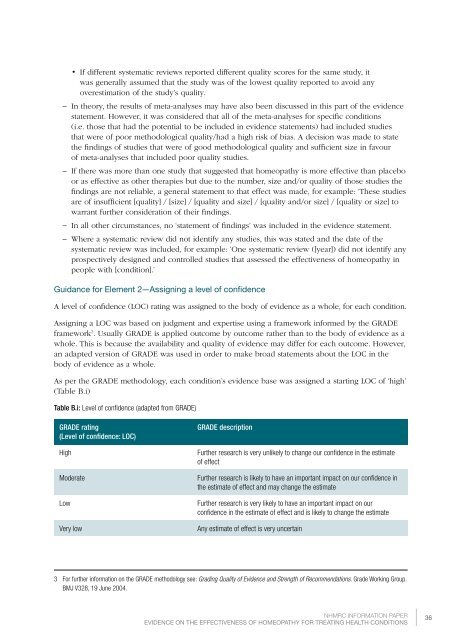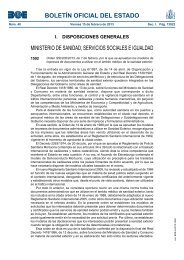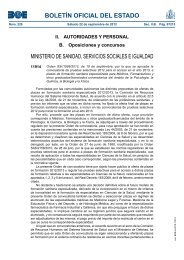cam02a_information_paper
cam02a_information_paper
cam02a_information_paper
You also want an ePaper? Increase the reach of your titles
YUMPU automatically turns print PDFs into web optimized ePapers that Google loves.
• If different systematic reviews reported different quality scores for the same study, it<br />
was generally assumed that the study was of the lowest quality reported to avoid any<br />
overestimation of the study’s quality.<br />
––<br />
In theory, the results of meta-analyses may have also been discussed in this part of the evidence<br />
statement. However, it was considered that all of the meta-analyses for specific conditions<br />
(i.e. those that had the potential to be included in evidence statements) had included studies<br />
that were of poor methodological quality/had a high risk of bias. A decision was made to state<br />
the findings of studies that were of good methodological quality and sufficient size in favour<br />
of meta-analyses that included poor quality studies.<br />
––<br />
If there was more than one study that suggested that homeopathy is more effective than placebo<br />
or as effective as other therapies but due to the number, size and/or quality of those studies the<br />
findings are not reliable, a general statement to that effect was made, for example: ‘These studies<br />
are of insufficient [quality] / [size] / [quality and size] / [quality and/or size] / [quality or size] to<br />
warrant further consideration of their findings.<br />
––<br />
In all other circumstances, no ‘statement of findings’ was included in the evidence statement.<br />
––<br />
Where a systematic review did not identify any studies, this was stated and the date of the<br />
systematic review was included, for example: ‘One systematic review ([year]) did not identify any<br />
prospectively designed and controlled studies that assessed the effectiveness of homeopathy in<br />
people with [condition].’<br />
Guidance for Element 2—Assigning a level of confidence<br />
A level of confidence (LOC) rating was assigned to the body of evidence as a whole, for each condition.<br />
Assigning a LOC was based on judgment and expertise using a framework informed by the GRADE<br />
framework 3 . Usually GRADE is applied outcome by outcome rather than to the body of evidence as a<br />
whole. This is because the availability and quality of evidence may differ for each outcome. However,<br />
an adapted version of GRADE was used in order to make broad statements about the LOC in the<br />
body of evidence as a whole.<br />
As per the GRADE methodology, each condition’s evidence base was assigned a starting LOC of ‘high’<br />
(Table B.i)<br />
Table B.i: Level of confidence (adapted from GRADE)<br />
GRADE rating<br />
(Level of confidence: LOC)<br />
High<br />
Moderate<br />
Low<br />
Very low<br />
GRADE description<br />
Further research is very unlikely to change our confidence in the estimate<br />
of effect<br />
Further research is likely to have an important impact on our confidence in<br />
the estimate of effect and may change the estimate<br />
Further research is very likely to have an important impact on our<br />
confidence in the estimate of effect and is likely to change the estimate<br />
Any estimate of effect is very uncertain<br />
3 For further <strong>information</strong> on the GRADE methodology see: Grading Quality of Evidence and Strength of Recommendations. Grade Working Group.<br />
BMJ V328, 19 June 2004.<br />
NHMRC INFORMATION PAPER<br />
EVIDENCE ON THE EFFECTIVENESS OF HOMEOPATHY FOR TREATING HEALTH CONDITIONS<br />
36






